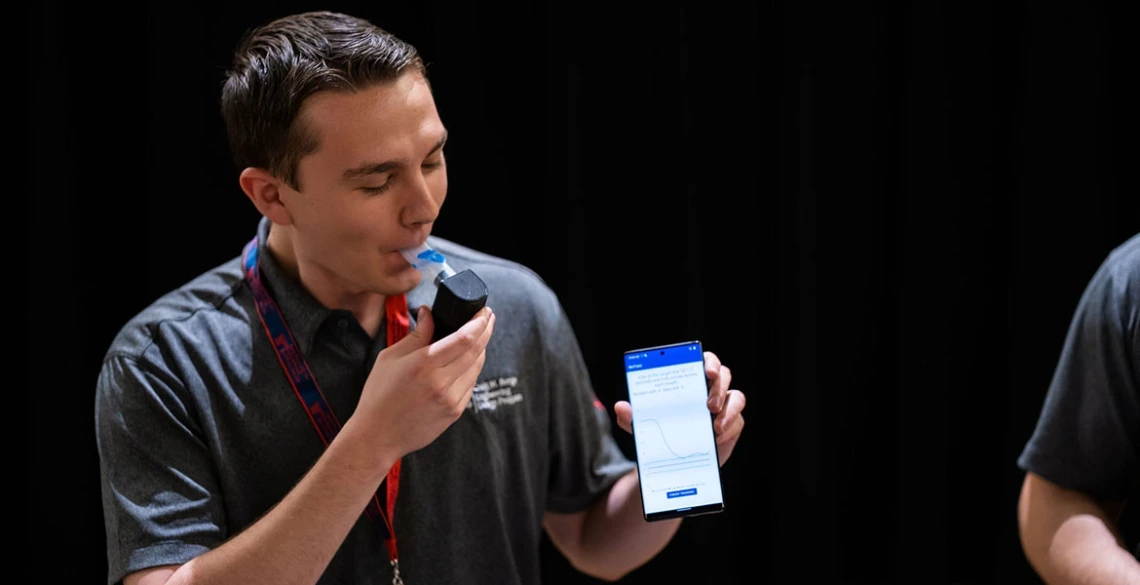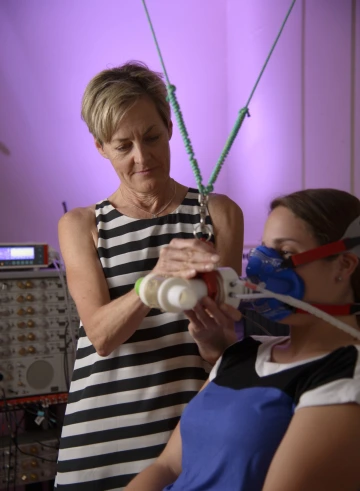Hold it now! App leverages resistive breath training for lower blood pressure

Capstone team member Nicholas Quatraro demonstrates the Inspiratory Muscle Strength Training (IMST) device at 2023 Craig M. Berge Design Day.
Courtesy of Fiona Bailey
Physiology Professor Fiona Bailey, working with a UA Engineering Senior Capstone team led by Dylan McGuire and Collin Preszler, has developed a device with an accompanying smartphone app that guides users through a resistive breathing training program (see UA23-254 on the TLA Inventions website). The app guides users through a daily five-minute exercise regimen, which Bailey's research has shown lowers peripheral vascular resistance and blood pressure and provides real-time visual feedback. The simplicity and effectiveness of the daily sessions make this tool a practical solution for those aiming to lower their blood pressure.

Fiona Bailey in the lab.
Courtesy of Fiona Bailey
The global burden of hypertension is a growing health issue. According to the World Health Organization, an estimated 1 billion people worldwide suffer from this condition, and it is a major risk factor for cardiovascular disease, stroke, heart attack and heart failure. Many individuals rely on medication to manage their blood pressure, however; medications often have side effects and may be unsuitable for many users. Non-pharmacological methods such as exercise are recommended but typically require a significant time commitment (~150mins/week) and may not provide enough impact for all patients.
Bailey’s innovation offers an alternative and complementary approach to these traditional methods by providing an accessible, time efficient and effective exercise intervention. “If you can complete just 30 breaths/day, five days a week over six weeks, you can achieve a significant (i.e., 8-10mmHg) reduction in blood pressure,” Bailey said. “Put in context, a blood pressure medication is considered effective, if it lowers blood pressure by at least ~5 mmHg. So, in many instances, the benefits of resistive breathing training can match and sometimes exceed those seen with an FDA approved blood pressure medication.”
After earning her bachelor’s in Melbourne, Australia, Bailey moved to the United States to attend the University of North Carolina at Chapel Hill to pursue a master’s degree focusing on the role of airway muscles in regulating airflow. Following completion of her Ph.D. and post-doctoral studies at the University of Arizona she continued research into respiratory control with a focus on sleep apnea and cardiovascular disease.
In 2020, Bailey was awarded a five-year, $3.4 million grant from the National Institute on Aging to build on her group’s previous research showing that resistive breathing training improved sleep and lowered blood pressure in older adults with sleep apnea. In collaboration with researchers at the University of Colorado Boulder, Bailey and her research team are studying the effects of resistive breathing training on sleep and blood pressure in older adults with sleep apnea and hypertension. In this study, eligible participants attend in-person supervised training sessions at the University of Arizona’s Clinical and Translational Sciences (CATS) and then train 5 minutes a day, 5 days a week, over 24 weeks at home. Participants are randomly assigned to one of two groups to evaluate the effects of high versus low resistive breathing training on sleep and blood pressure.
Bailey argues the biggest challenges in developing treatments for obstructive sleep apnea are effectiveness, affordability and accessibility. While continuous positive airway pressure, or CPAP, is an effective treatment for sleep apnea, as many as 40% of users don’t wear the device throughout the night or find the device otherwise burdensome to use and transport. Likewise, despite exciting innovations in the surgical treatment of sleep apnea, the associated costs too often are prohibitive. Until these challenges can be resolved, traditional “lifestyle” modifications including diet and exercise will remain among the first-line treatments for all stages of hypertension.
Learn more
This technology is available for license. See UA23-254, A Resistive Breathing Circuit for use in Lowering Blood Pressure.

